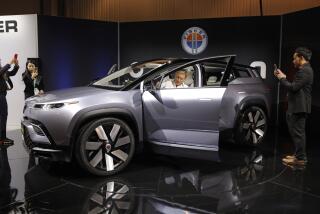Its refining moment
The car you see on this page is subtle. No, seriously, ignoring the blown-out front fender deltoids, the heinous sacrilege of sport tires and roof-extending rear wing the size of a snowboard, and ignoring the Talmudic specificity of the name -- Subaru Impreza WRX STI -- there is a lot of nuance here. It’s nuance fired out of a howitzer at point-blank range into your face, but you could still easily miss it. Yes, that’s what impresses me after a rib-bruising half-hour with this 305-hp, all-wheel-drive samurai license-killer: its deep allusiveness and indirection. It’s practically Pynchon-like.
It’s helpful, in the face of such dialogical quietude, to start at the beginning. The Impreza line was redesigned for model year 2008 and I think we can all agree that is a good thing. The sheet metal has been vastly improved, contemporized and brought into line with Subaru’s new corporate look. The ogre spell has been broken.
And here comes the subtlety. The 2008 Impreza comes in two profiles, sedan and five-door hatch, and three trim levels: the base Impreza, with a non-turbocharged, 170-hp 2.5-liter flat-four and all-wheel drive; the Impreza WRX, with a turbocharged version of same pumping out 224 hp; and le grand fromage, the WRX STI , nearly $40,000 with full kit, with a set-to-kill version of the flat-four crammed under the mono-nostril hood, along with as much turbo and intercooler, hoses and tubing as could fit. Honestly, the STI has more plumbing than a men’s room at Dodger stadium.
The STI is a car utterly obsessed upon by a generation of young car dementos and players of Gran Turismo. Basically a de-tuned and street-able version of the company’s World Rally Championship competition car, the STI is, indeed, a car culture unto itself. And among the faithful, the 2008 STI (in hatch shape only) cannot but be greeted with hosannas. With its steroidal fender bulges shrouding (optional) BBS sport wheels and brake ducting big enough to devour a condor, the STI wallows in extra-legal disrepute like a pig in mud and goes like the very stink upon said pigs’ back.
And yet, as with the base car upon which it is, uh, based, the STI is quite a bit more refined than the previous generation, which to the core audience is a little like having its favorite drug cut with baby powder. The wheelbase is longer, the chassis couplings more substantial, and the company’s Noise-Vibration and Harshness team have refined some of the rawness out of a car dearly loved for rawness. These are not among my concerns, though. The car certainly doesn’t beat you up quite like the previous model did, but you’re still plenty tenderized after a long day in the saddle.
Attentive readers may remember that I drove the WRX hatch a couple of months ago, and my biggest complaint with that car had to do with the excess body roll allowed by the suspension. What really bothered me was that in quick, corner-to-corner transitions, the car seemed to have ungainly suspension rebound and tended to get all out of sorts. “Deranged” was the word I used, and the word the Subaru brass took exception to. Their argument was that the softer spring-shock-roll settings made the car quicker and saved tires. Yeah, well, it still felt as if I spent more time than necessary gathering up the car after a hard corner so, with the greatest respect, Subaru-san, bugger off.
The STI, however, has the suspension stubbed down noticeably tighter. This chassis tune makes me much happier. The initial bite on turn-in is sharper -- thanks to the mad rubber, 40-series Dunlop SP600s -- the roll transition is more controlled, and the car remained poised even if I had to saw the wheel a bit to correct my line through a corner. It corners insanely well. Like most all-wheel-drive cars, it tends to understeer and it’s just about impossible to get it to rotate with power, so you have to set up for corners with more than usual care. Rough pavement could make the car skitter phonograph style but only if the car is well and truly heeled over. The steering is heavy (really heavy, when the center-diff is fully locked; more about that in a moment) but tightfisted and accurate. The brakes have got major authority. And you can’t fault the driving position: The sport seats are terrific and the pedal position perfect for heel-and-toe driving.
As a canyon-killer, the STI offers major game, and is one of the few cars in this price range that can induce passenger car-sickness like a Ferrari. Oddly, though, in the straight-ahead of day-to-day driving, the car feels slower than my memory of the old STI. It weighs the same (3,360 pounds, according to Car and Driver) and has 12 more hp. So why does it run like the old car with a slight head cold?
Partly it’s a matter of launch characteristics. To coax a proper hole-shot out of the car you have to abuse the drivetrain something marvelously, letting loose of the clutch with the engine in a scalding rage, somewhere in the 5,000 rpm range. I did that exactly once before my sense of sympathy prevailed. Also, the electronic redline is set to a warranty-preserving 6,700 rpm, and so it always feels as if you’re short-shifting, even though you’re not.
So much subtlety, so little time. To be sure, the STI’s signature technology is its multifarious suite of electronic interventions, the controls for which are clustered in the center console between the front seats. First, there’s the throttle-mapping control -- called SI-Drive -- which allows drivers to choose between “sport,” “sharp” and “intelligent.” This has to do with the way the car answers to the whip. “Intelligent” mode gives the car a lazy, fuel-saving character, while “sharp” gives the car the zingy, frenetic character the lads would expect. The traction and stability control also has three modes: on, off, and sport, which lowers the computer’s intervention level. And finally, the Driver Controlled Center Differential, which allows drivers with extraordinarily calibrated keisters to dial in the precise degree of torque split between the front and rear axle, anywhere from full rear bias (59%) to a 50-50 fore-aft split, with or without the computer helping out.
This is the sort of unusable overcapacity fetishized in high-end audio systems and fancy cellphones. To muck about with all these variables in daily driving is like taking your mixed-gas scuba rig to the bottom of a bathtub or straightening a picture on the wall with a surveyor’s transit. I just left the thing on auto mode and, lo, it went like good gobs of silly. Oh dear. Have I been too subtle?
2008 Subaru WRX STI Base price: $35,640Price, as tested: $39,440Powertrain: Turbocharged and intercooled 2.5-liter, DOHC flat-four with variable-valve timing; six-speed manual transmission; full-time all-wheel drive with driver-adjustable limited-slip center differential and limited-slip front and rear differentials.Horsepower: 305 at 6,000 rpmTorque: 290 pound-feet at 4,000 rpmCurb weight: 3,360 pounds*0-60 mph: 5.1 seconds*Wheelbase: 103.3 inchesOverall length: 173.8 inchesEPA fuel economy: 17 miles per gallon city, 23 mpg highwayFinal thoughts: As subtle as a case of rabies*Source: Car and Driver magazine
More to Read
Start your day right
Sign up for Essential California for news, features and recommendations from the L.A. Times and beyond in your inbox six days a week.
You may occasionally receive promotional content from the Los Angeles Times.






